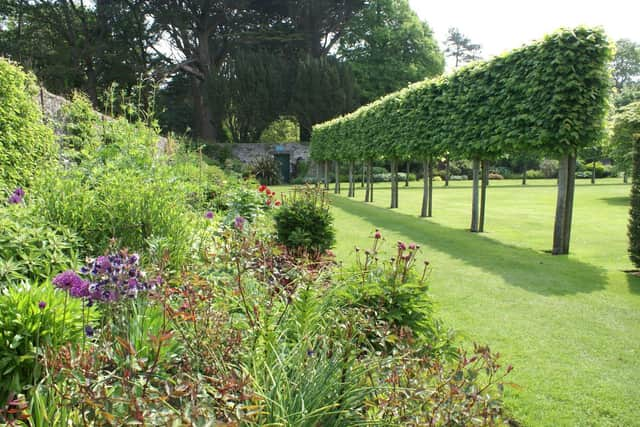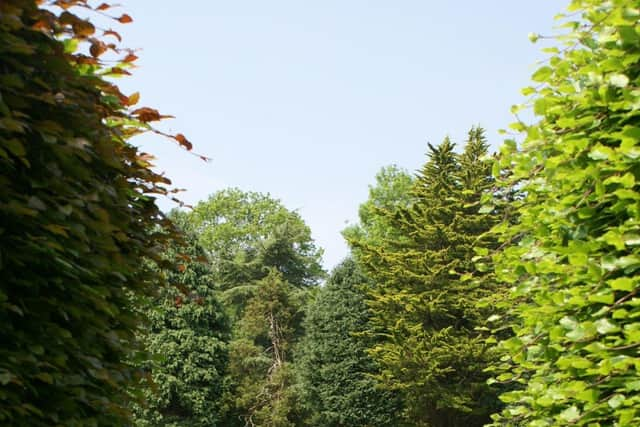Historic Walled Garden at Glenarm was temporarily closed as a mark of respect


It was held on Wednesday morning, and due to Covid restrictions the service was by invitation only, though the public was invited to join “the traditional procession behind the horse and cart from the church back to Glenarm Castle following the funeral service.”
Family, friends and estate staff then proceeded to the family burial site.
Advertisement
Hide AdAdvertisement
Hide Ad“As a mark of respect to the late Lord Antrim”, Glenarm Castle’s website announced, “our businesses including the Walled Garden and all of our retail and food outlets will remain closed for the whole of Wednesday 11th August.”


Since 2001 the late Viscount and his wife, together with a dedicated team, have been restoring the historic garden which was opened to the public for the first time in 2005.
The spectacularly beautiful garden contains what was described by acclaimed horticulturist, garden-writer and designer Fionnuala Fallon as “possibly the most perfectly manicured stretch of lawn on the whole island.”
Roamer is by no means an expert in horticulture (quite the opposite!) but I’ve often reported on this page from notable gardens, local and further afield, and they’re always very special places evoking long-lasting memories.
Advertisement
Hide AdAdvertisement
Hide AdMy visit to Glenarm Castle’s Walled Garden five years ago was probably the most memorable of them all, though at the time I knew very little about Alexander Randal Mark McDonnell who was buried on Wednesday.


Born in London on 3 February 1935, he went to the historic Downside School in England, and then to the famous Ruskin School of Art after reading history at Oxford.
He worked in London’s Tate Gallery, returned to Glenarm to run the estate and work as a conservator in the Ulster Museum, and went back to the Tate in the early 1970s to become Keeper of Conservation.
As well as an internationally-acclaimed restorer of paintings, he was also an artist whose work “subtly observed his native Glens in Northern Ireland”, wrote an obituarist.
Advertisement
Hide AdAdvertisement
Hide AdHis other interests included London’s historic Fishmongers’ Company, Ulster Television and Glenarm’s Northern Salmon Company.
Vintage cars was another of his passions.
I’ll leave Roamer-readers to peruse the Antrim’s intriguing family history online at glenarmcastle.com and end today’s page with a return to the page I penned five years ago about the wonderful Castle and Walled Garden, open again to the public after the late Earl’s funeral, with full details on the website.
Along with the many other attractions on the estate and built in one of Northern Ireland’s oldest settlements, this is truly a national treasure.
It is one of Ireland’s oldest estates, incorporating one of the island’s oldest walled gardens.
Advertisement
Hide AdAdvertisement
Hide AdThe present building has been in the McDonnell family since it was first built in 1636.
It is a beautiful ‘Jacobethan’-style mansion, a designation coined by John Betjeman for a mixed architectural repertory of English Renaissance, Elizabethan and Jacobean.
The mansion’s exquisite interiors are set with superb examples of Irish furniture and a long line of family portraits. It is only open to the public occasionally, with group tours subject to availability, but the magnificent Walled Garden, with its shop and tea room (in the old mushroom house) is open Monday to Sunday, seasonally, 9am to 5pm.
Originally created to supply the ‘big house’ with fresh fruit and vegetables, the Walled Garden is a progression of endearingly named spaces (or ‘rooms’ as proper landscape designers apparently call them) leading from the old Glass House to the Yew Circle enclosing the herb garden, and to a steep, spiral, grass-mound called The Mount.
Advertisement
Hide AdAdvertisement
Hide AdThe yew hedge is one of the oldest-remaining features of the garden, dating from the 1820s.
Four stone capitols repose gracefully on the outer edges of the magnificently herb-scented borders - a carved quartet of antiquities that belonged originally to the Earl-Bishop of Londonderry and are thought to have come from his palace at Downhill.
The aptly-named Hot Border is one of the most vivid sights in the garden - thick flames of contrasting colours set against a rustic-skim wall.
The herbaceous border is filled with bright reds, pinks and oranges throughout the season - from tulips and peonies in early summer to bright dahlias and penstemons (late summer-flowering perennials greatly loved by Victorian gardeners) in the early autumn.
Advertisement
Hide AdAdvertisement
Hide AdThe Hot Border contrasts with two herbaceous ‘cool’ borders, less ‘in your face’ but similarly fragrant in the nose.
Fed by pebble-lined rills or rivulets, a stone-paved fountain and cascade disperses the gentle sound of tinkling, babbling and burbling water into the air.
The pebbles are from Glenarm beach.
The 19th century mushroom-house, converted into a charming tea room, opens onto a picture-postcard ‘street’ of former workers’ cottages, grey-slated and stone-built, immaculately conserved.
Sculpted stone prudently punctuates the lawns and foliage - a bulbous sun-dial, a pointed obelisk, wide chiselled-steps, and an exquisite stone image of the Madonna and Child, sculpted by Angela Sykes, later Countess of Antrim, the late Earl’s mother.
The enormously talented artist carved this serenely beautiful Madonna and Child when she was only 16 years old.
For more, see glenarmcastle.com